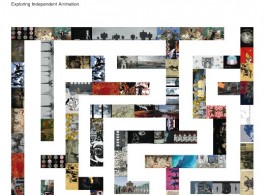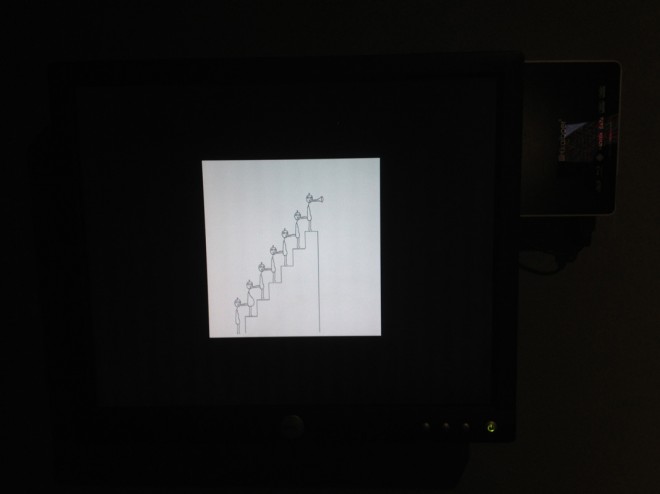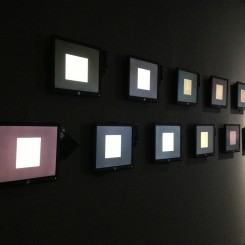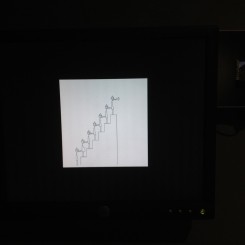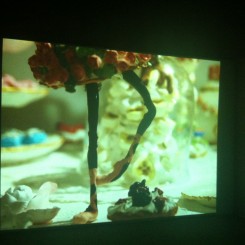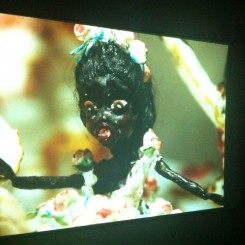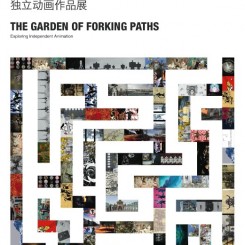Press Release
Independent Animation is a Winding Path…
The Chinese expression Qu Jing Tong You – literally “a winding path leads to quiet seclusion” – conveys the idea of a conceptual space out of time, or better, a space suspended in a non-linear and non-eschatological time, where (and when) visions of life’s countless circumstances can be repeatedly materialized and delivered.
The inner wisdom of this proverb seems to be elaborated in the short story “The Garden of Forking Paths”, written by Jorge Luis Borges: in it the spy Yu Tsun, while hopelessly trying to escape capture from his enemy, an inevitable destiny, runs into a revelation about the ancestor Ts’ui Ben and his unfinished novel, planned like an inextricable literary labyrinth – the “garden of forking paths” itself. Borges’s narrative strategy, as it is articulated, contains a core of simple truth: the world is just too layered to be embraced and understood at a glance, so are its phenomena. To enumerate them is impossible, therefore, instead of making lists – another concept Borges was fascinated by – of what can be found “under the sky” (in Chinese tian xia) it is far better to try to examine the mechanisms of their functioning: repetitions, recurring patterns or slight shifts in perspective, and again turning points and unexpected convergences.
In the hypertext Borges manages to construct, time and space become unbreakable, as in the modern (and postmodern) theoretical framework. The labyrinth is the space and the time one employs to walk through it. This is also at the core of time-based technologies and multimedia art. A careful combination of time and space generates coordinated movement, which is the premise of animation. The exploration of all the chances animated images involve and allow is the premise of independent animation.
The Meaning of Exploration
The idea of “exploration” itself is the starting point of the exhibition: exploration of virtual worlds and exploration of time, in the form of sequences of images moving on the screen. Animation is also one of the directest ways for artists to explore their personal imagery, as well as the collectively inbuilt visual culture(s). Beginning as a pure investigation into the depths of mind, with its fears, expectations, disillusions, temporary or long-term escapes, it becomes paradigmatic of a certain human condition and can be shared through its exposure: the unbridled layout of its contents and the amplification of the evils we are confronted with can relieve from the pain of being alive, and deliver from the sense of threat existence occasionally entails; or on the contrary amplify it. In a word, by liberating from a burden of unspoken words and hidden images, these works can liberate us, showing alternatives to pre-established models and new ways of dealing not only and simply with what is real, but with what we see as real.
Even though the technology animation involves is not as intuitive and available to all as video and photography have now become, artists can have a relatively easy access to it, thanks to the widespread diffusion of the relevant software. Yet independent animation is an adventure into a terrain full of uncertainties, risks and necessary prerequisites: above all when it comes to the restraints imposed by time and money, the two factors governing commercial animation. It certainly is a time and labor consuming technology, but as long as it primarily remains self-funded and unconstrained, it can also be independent.
Like every other art form, animation hinges upon an in-depth knowledge of past and present history, but representing an expression of the so-called “Cross Media”, it also relies on the capacity to anticipate new directions and put them in relation with each other. We are strongly persuaded that the painstaking research artists carry on, and the utmost attention they show towards the objective of their works, embody the contradictions of a language which through apparent fun and disengagement conveys disruptive messages.
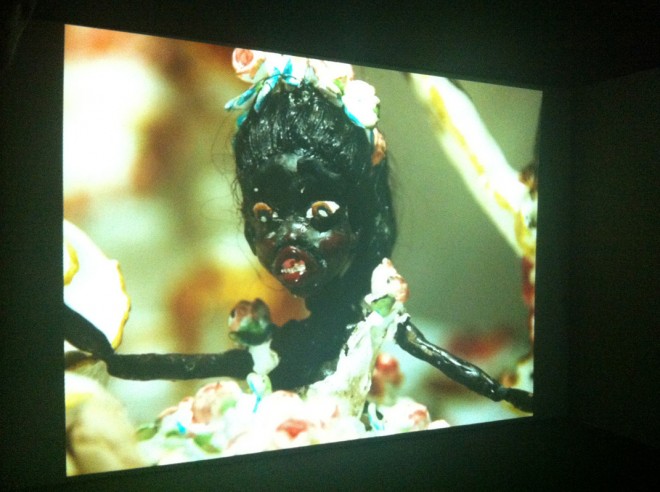
Nathalie Djurberg and Hans Berg, “I found myself Alone,” clay animation, 9’45”, 2008
娜塔莉 杜尔伯格和汉斯 伯格, “孤独的我”, 粘土动画, 9’45”,2008
A Maze of Artworks
A large part of the exhibited works has been selected from the first Shenzhen Biennale of Independent Animation (held at OCT Loft from 22 December 2012 to 22 March 2013). OCAT Shanghai has added to the list other relevant artists who have worked with and on animation – Riccardo Arena, Nathalie Djurberg (in China for the first time), Igor Imhoff, Feng Mengbo, Gu Dexin, William Kentridge, Lu Yang – and placed their works within a critical and theoretical frame in which the city of Shanghai is a crucial crossroad of cultural experiences and a platform for international dialogue.
The exhibition is articulated around two spaces which reflect two main thematic spheres: the first gathers works relating to society, natural versus urban landscapes, individual identity and gender issues (Cao Fei, Bu Hua, Nathalie Djurberg, William Kentridge, Sun Xun, Zhang Xiaotao); in the second space visitors will find videos and films which through a more abstract language explores the dynamic potential of images (AES + F, Dai Hua, Lu Yang, Miao Xiaochun, Federico Solmi, Diego Zuelli).
The participation of an artist like William Kentridge, who has regenerated, perhaps even revolutionized the language of independent animation, proves the degree of completeness of this exhibition, aimed at presenting to the Chinese and international public the most interesting outcomes of recent independent animation by young yet well-assessed artists, as well as the finest achievements of renowned artists making occasional or exclusive use of animation language and technology. Conceived as a maze to get lost in and reemerge, just like a labyrinth, or the path the title refers to, it can be temporarily deceitful, but it also represents the unlimited possibilities artists have to imagine, hence create, and opens up new ones for people to get closer to their visions.
A century ago or so, the barges that sailed down the Suzhou river, flowing just outside the exhibition halls, carried all sorts of goods to the warehouses of the National Industrial Bank of China, where today priceless fantasies are collected and shared. The storerooms located inside the cradle of Chinese industry and commerce, former seat of Shanghai General Chamber of Commerce and residence of the first Chinese Industrialist Shen Yu Li, have now become a center for contemporary art. OCAT Shanghai takes advantage of this unique location – Lujiazui skyline can be sighted outside the exhibition halls – to function as a thread between past and present, committing itself to maintain continuity in history and build a dialogue with the world, highlighting at the same time Shanghai’s uniqueness.
About the curators
Mariagrazia Costantino (1980) is a sinologist, an art and film critic and a freelance curator from Italy. She holds a BA in Chinese language and History of Art from the University of Rome “La Sapienza”, an MA in Media and Film from SOAS, London, and a Ph.D. in Film Studies from “Roma Tre” University in Rome. Her Ph.D. thesis concerns the ideological representation of urban space in Cinema from East Asia.
In 2002 she obtained a scholarship from P.R. China and the Italian Ministry of Foreign Affairs for one year research at the New Media Department of the Chinese National Academy of Fine Arts in Hangzhou. She has also studied at the Peking University.
In Italy Mariagrazia has curated several exhibitions of Chinese and Italian video artists. In 2005 she has brought to Rome the widest selection of video works from China. In the same year she has a worked as producer for the 52nd Venice Biennale.
She is co-author of the book Arte Contemporanea Cinese (Electa, 2006), and one of the contributors of World Film Locations: Beijing (Intellect Books, 2012) and the upcoming World Film Locations: Shanghai.
She is currently art director at OCAT, OCT Contemporary Art Terminal Shanghai.
Wang Chunchen is the Head of the Department of Curatorial Research of CAFA Art Museum, Beijing, as well as an Adjunct Curator of the Broad Art Museum of Michigan State University.
In 2009 he was honored with the coveted Chinese Contemporary Art Award. The result of this award is the writing and publication of the book “Art Intervenes in Society”.
He has curated the following exhibitions: Conceptual Renewal: A Brief History of Chinese Contemporary Photography (2012); The First Shenzhen Biennale of Independent Animation, (2012); Sub-phenomena: A Report of the State of Young Chinese Artists (2012); CAFAM Biennale 2011; Super-Organism, 2011. Wang has been appointed curator of the Chinese Pavillion for the upcoming 55th Venice Biennale.
Wang has played a great influence on Chinese contemporary art criticism by translating over ten books of art history and theory, such as After the End of Art (A.C. Danto), Art Since 1940, Theory in Contemporary Art Since 1985, Postmodernism, Post-socialism and Beyond, etc. His critical essays are collected in the book The Democracy of Art and The Politics of Images.
From 3 May to 28 July 2013 at OCAT, OCT Contemporary Art Terminal Shanghai, 1016 North Suzhou Road, Shanghai.
Opening: 3 May 2013, from 5pm to 7:30pm
Exhibition Director: Yuan Jingping
Academic Director: Zhang Peili
Curators: Mariagrazia Costantino, Wang Chunchen.
Curatorial Assistants: Zhu Hua, Tao Hanchen

